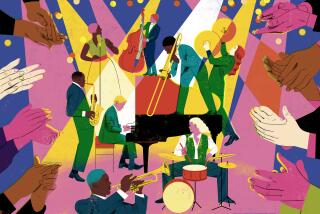Louis, Ella, Billie, Sarah, Carmen & Co.
The quickest way to rile a group of jazz fans is to ask for their definitions of jazz singing. Listeners who have no difficulty agreeing upon the relative virtues of New Orleans clarinetist George Lewis and free-jazz saxophonist Ornette Coleman can become seriously contentious when discussing the jazz merits of, say, Ray Charles or Frank Sinatra.
This five-CD compendium--subtitled “A Smithsonian Collection of Jazz Vocals From 1919 to 1994”--doesn’t presume to solve definition problems, although the program notes by producer Robert G. O’Meally give some insightful thoughts. But the real focus is to offer a “representative survey of the types of singing associated with jazz” and serve as a “sampler of the greatest artists in each category.”
So far, so good. And there’s no question that virtually every individual even remotely identified as a jazz singer is included. There are all the obvious choices--the seminal vocals of Louis Armstrong, the great triumvirate of Billie Holiday, Ella Fitzgerald and Sarah Vaughan, the articulate Carmen McRae, the briskly swinging Anita O’Day, the blues-based appeal of Joe Williams and Billy Eckstine, the seductive phrasing of Shirley Horn. But there are dozens of others as well: Mildred Bailey, Al Hibbler, Dakota Staton, Nina Simone, June Christy, Johnny Hartman, Betty Carter, Helen Merrill, Abbey Lincoln and Mark Murphy among them--and, yes, Sinatra too.
The question in a package of this size and scope is how to present it. Avoiding the obvious decision to program the entire sequence of material in chronological fashion, O’Meally and co-producer Bruce Talbot instead elected to break the music up into eight program categories.
And that’s where matters sometimes get a bit sticky. Categories titled “Steeped in the Blues” and “Straight Out of Church” are logical enough (although the set of three gospel performances is too brief to include such obvious choices as Marion Williams and Sister Rosetta Tharpe). Appropriate, too, are segments focusing upon standards, scat singing and vocalese. But categories titled “Let’s Have a Party” and “Novelties and Take-Offs” are, at best, vague, and include items that easily cross over into other areas.
But the arbitrary layout of the material in no way diminishes the value of this remarkably inclusive collection, which--with the possible exception of the youngest, most contemporary artists--manages to touch upon virtually every performer and every style related to the notion of jazz singing.
Every jazz fan will find favorites of his or her own. And there are plenty of classics: lots of Armstrong, including a duet with Fitzgerald (who also is present, singing superb ballads, notably “Someone to Watch Over Me” with pianist Ellis Larkins); contrasting versions of “I’ve Got You Under My Skin” by Ethel Waters and Holiday (also represented by her searing rendering of “Strange Fruit”); Anita O’Day and Roy Eldridge romping through “Let Me Off Uptown”; Armstrong and Jack Teagarden pairing up for “Rockin’ Chair”; Vaughan’s sumptuous “Prelude to a Kiss”; Joe Williams with Lambert, Hendricks & Ross in an exuberant “Goin’ to Chicago.” And much, much more.
There is also the unexpected appeal of the offbeat numbers: Slim Gaillard’s hilarious “Babalu”; Pearl Bailey and Moms Mabley doing “Saturday Night Fish Fry”; a youthful Betty Carter brilliantly scatting through “Frenesi”; bassists Slam Stewart and Major Holley’s variation on “Close Your Eyes,” subtitled “Shut Yo’ Mouth.”
Equally intriguing, for the insight they provide into the elusive definition of jazz singing, are tracks by instrumentalists Ben Webster, Lester Young and Clark Terry. Webster rehearses a Danish band, using both vocal and verbal exhortations and illustrations to guide them into a feeling of drive and swing. And Young’s “Takes Two to Tango” (a between-takes impromptu with Oscar Peterson) and Terry’s “Mumbles” cruise the elusive area between words and music.
*
Albums are rated on a scale of one star (poor) to four stars (excellent).
More to Read
The biggest entertainment stories
Get our big stories about Hollywood, film, television, music, arts, culture and more right in your inbox as soon as they publish.
You may occasionally receive promotional content from the Los Angeles Times.










